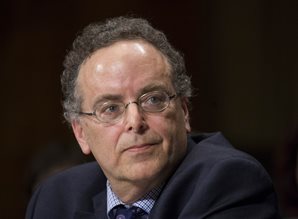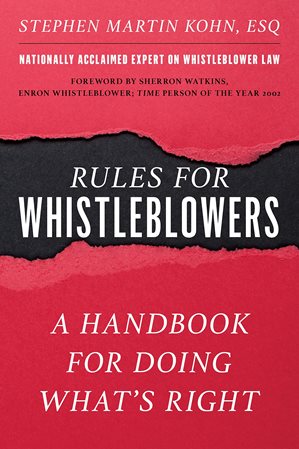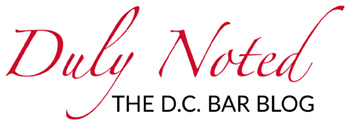Author Chats
Stephen M. Kohn Explains How to Successfully Bring a Whistleblower Suit
June 20, 2023
Kohn, Kohn & Colapinto LLP cofounding partner Stephen Martin Kohn has authored numerous books and articles on the topics of qui tam and whistleblower law. His latest, Rules for Whistleblowers: A Handbook for Doing What’s Right, delivers on the title’s promise, providing a comprehensive overview of what it takes to bring a successful whistleblower suit.
articles on the topics of qui tam and whistleblower law. His latest, Rules for Whistleblowers: A Handbook for Doing What’s Right, delivers on the title’s promise, providing a comprehensive overview of what it takes to bring a successful whistleblower suit.
Kohn draws upon his significant experience in the field. His past representation of whistleblowers has resulted in multiple record-breaking rewards, earning clients nine-figure sums for the disclosure of billions of dollars in corporate fraud and criminal acts. In addition to his involvement in precedent-setting litigation, Kohn has been involved in the drafting of key whistleblower legislation and regulatory rules.
His prior publications have included scholarly texts on False Claim Act and whistleblower suits, litigation handbooks, a guide to legal protections for whistleblowers, and a 2017 handbook for whistleblowers — a topic that his current book expands upon and updates.
Here, Kohn speaks with the D.C. Bar about his extensive involvement in this evolving area of law.
How has the practice of whistleblower law changed during your career?
The whistleblower law that I practiced when I started in 1984 does not resemble what is going on today. Not one law that I used back then do I use today. The laws have revolutionized … They’ve become super-effective. They’ve become much more protective of whistleblowers, and it’s one area of public interest law that has expanded tremendously over the past 40 years.
But there is a complete misunderstanding of what whistleblowing is. People look at cases like Edward Snowden and Daniel Ellsberg, or this new HBO series about the Reality Winner, and they fixate on the notion that this is what whistleblowing is.
Yes, it is, but [these examples are] one in a thousand. The new whistleblowing is about money laundering, securities, commodities, tax evasion. They have these super-effective laws, but, in many ways, the practice is secret, so there are almost no published decisions. Take the IRS, for example — they’ve given out over a billion dollars in awards, well over a billion, yet none of their decisions are public. So, there’s no ability to go on Lexis[Nexis] and learn about it. It’s not taught in any law school.
Then, you go to the Dodd–Frank Act, where 65,000 whistleblowers have filed claims, almost all of them anonymous and confidential … When they give out these awards, which can be extremely large, they don’t tell you who the whistleblower is. They don’t tell you what company got sanctioned because of these new rules on anonymity and confidentiality. So, you have this massive area of law that doesn’t appear on LexisNexis, isn’t taught in law schools, and the way decisions are issued, they’re fairly invisible.
What led you to write a handbook for whistleblowers?
Because this area is so unique and so new, it’s absolutely essential that practitioners know the nuances. Very little mistakes can lead to big errors, like the timing of filing, who you speak to, what is considered protected, what qualifies for a reward, and who gets disqualified and why.
The government has been paying a lot of rewards, but they deny a lot, and anyone who thinks getting a $50 million check from the government for a whistleblower is easy … they don’t know what’s going on in this world. You’ve got to be right. You’ve got to get it correct. There’s so much at stake.
When a whistleblower comes to your office, if you blow their confidentiality, they may get blacklisted for life. If you make a mistake, they may lose a $5 or $10 million award, so the stakes are super-high. The risks are super-high.
Finally, there is public interest at stake. Let’s just start adding it up. In the Dodd–Frank program, the SEC alone has returned $1.5 billion to harmed investors based on whistleblower disclosures.
In foreign corruption, which is a very big deal, they’ve been tackling some of the largest [cases brought under the] Foreign Corrupt Practices Act. Money laundering is a new area. Danske Bank just got nailed for a $2 billion penalty. This law was passed to enable people around the world to turn in the Russian oligarchs. Right now, under this law, Bitcoin services are being sanctioned and Russian oligarchs are being turned in. People are illegally paying bribes in order to gain access to mining or are destroying the rainforest. These are all actionable cases.
The scope is massive. The benefits to the public are so important, and the ability of the whistleblower to remain confidential and not lose their job and obtain compensation … it’s a whole new world. The reason [I wrote] the book is because [whistleblowing] is so different from the popular conceptions.
When you think of whistleblowing, you think of a loud public disclosure. The word “whistleblowing” makes you think you should hold your ears, but now, the best whistleblowers … no one knows they even exist. They go confidential and anonymous. They are silent.
How is your book organized?
The book begins with the big questions: What road do you go down? Retaliation or rewards or both? Right from the beginning, I’m examining the pitfalls and the traps. For example … most people think that the statute of limitations sets a deadline for filing a case. That’s true, but not in our reward laws. In our reward laws, first-to-file gets everything. So, the statute of limitations is yesterday. There are ways that lawyers have been trained that are no longer relevant. If a client walks in with evidence of insider trading, for example, you’ve got to go right in. Otherwise, someone else will beat you to it.
There are numerous traps that I explain right in the beginning of the book. One lesson is to begin to protect yourself from the moment that you think you might become a whistleblower. Don’t wait to be fired. If you have evidence of wrongdoing, you need to start planning — whether you become a whistleblower or not is secondary. You have to figure out how you will proceed.
So, part one is about triage. In part two, I go over all of the reward laws because they are now the dominant method of compensation and also the dominant way whistleblowers are going forward. As I say, under the SEC alone there are 65,000 claims … way more than OSHA, way more than anything else.
There is no one whistleblower law. There are about 65, and each of the reward laws is different. There are different filings, different procedures, different agencies, and different rules. They each tackle a distinct area of the economy.
Once you look at this whole fabric, there’s a very strong chance that a whistleblower with a significant allegation will be covered under one of these, what I call, “supersonic laws.” From there, you have to be very careful because a small mistake can lead to complete disaster.
The next section is all about retaliation. It covers how to handle a retaliation case. I think the most important part of that section is the portion about how you prove retaliation, which is always the most difficult part of the case. We also hit some of the hot topics like whether you can tape, how you can remove documents, whether you have to work with compliance, what to do if you are an auditor … there are lots of little sub-issues that always arise in a case.
Your book frequently recounts illustrative examples from landmark whistleblower litigation. How do these historic cases help contemporary whistleblowers navigate the system?
I think, ultimately, the two most important chapters are the introduction, which talks about America’s first whistleblowers in 1777, and the conclusion, which discusses why whistleblowing works. These two bookends explain everything that is in the middle.
We begin with the Revolution. It’s an amazing story about how the founders of our country dealt with the first whistleblowers that came up six months after the signing of the Declaration of Independence, blowing the whistle on a commander of the U.S. Navy for serious misconduct. They were very pro-whistleblower. It created this credo, this American concept of democracy, that was intertwined with the right to expose wrongdoing. If you look at what happened there, the laws that come afterward flow from this perspective.
From there, if we move to the conclusion, this, to me, says it all. Why have we gotten such great whistleblower laws? Why have whistleblowers been paid close to $10 billion in rewards? It’s an unbelievable number. Why have our laws expanded?
They grow because whistleblowers use them, and whistleblowing unlocks the key to successfully fighting white-collar crime and corruption. My conclusion begins with the criminologist who termed the phrase “white-collar crime” in the 1930s and discussed what white-collar crime was. He called it the worst crime in the world. It’s not stealing from one person; it’s stealing from a million people. The volume of the crime is worse, and he said that it undermines democracy. It undermines the rule of law, creates cynicism, and fuels authoritarianism.
He laid out the problem but had no solution. The second person I discuss is the prize-winning economist who developed the economic theory of crime. He says that the amount of crime is an economic formulation … Detection times punishment equals rate of crime. If your risk of detection is high and punishment is high, crime is low. In the context of white-collar crime, he called for very high punishments.
We see that now, with multimillion or billion-dollar fines, but he couldn’t figure out detection. But then, we got the first whistleblower claims law, the False Claims Act, which incentivized detection by paying rewards. All of a sudden, the detection aspect of the formula was available, and it totally works.
Everything else in the book is all about detection and protection. How can you detect white-collar crime, how can you report it as a whistleblower, and how can you completely protect yourself when you do it?
In my largest case ever, in which the whistleblower received over $150 million, the company did not know there was a whistleblower. Not only was there no retaliation, they didn’t even know to look for somebody. That is a perfect case. It’s essentially the opposite of the stereotype of whistleblowing.
Where can readers find out more about you and your work?
To learn more you can visit kkc.com and connect with or follow me on LinkedIn, Twitter, Facebook, and YouTube. If you’re interested in purchasing a copy of Rules for Whistleblowers, it is available on Amazon, Barnes & Noble, and wherever books are sold.


